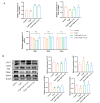Curcumin liposomes alleviate senescence of bone marrow mesenchymal stem cells by activating mitophagy
- PMID: 39732809
- PMCID: PMC11682429
- DOI: 10.1038/s41598-024-82614-1
Curcumin liposomes alleviate senescence of bone marrow mesenchymal stem cells by activating mitophagy
Abstract
The senescence of mesenchymal stem cells (MSCs) is closely related to aging and degenerative diseases. Curcumin exhibits antioxidant and anti-inflammatory effects and has been extensively used in anti-cancer and anti-aging applications. Studies have shown that curcumin can promote osteogenic differentiation, autophagy and proliferation of MSCs. Liposome, as a nano-carrier, provides a feasible strategy for improving the bioavailability and controlled-release profile of curcumin.This study aimed to evaluate the effects of curcumin liposomes (Cur-Lip) on the senescence of rat bone marrow mesenchymal stem cells (rBMSCs). Based on network pharmacology, we predicted the targets and mechanisms of curcumin on senescence of MSC. 23 key targets of Cur were associated with MSC senescence were screened out and mitophagy signaling was significantly enriched. Cur-Lip treatment alleviated senescence of D-galactose (D-gal)-induced rBMSCs, protected mitochondrial function, and activated mitophagy, which may be related to mitochondrial fission. Inhibition of mitophagy attenuated the protective effects of Cur-lip on mitochondrial function and senescence of rBMSCs. Our findings suggested that Cur-Lip could alleviate senescence of rBMSC and improve mitochondrial function by activating mitophagy.
Keywords: Curcumin liposomes; Mitophagy; Network pharmacology; Senescence; rBMSCs.
© 2024. The Author(s).
Conflict of interest statement
Declarations. Competing interests: The authors declare no competing interests. Ethical approval: The study was approved by the Ethics Committee of the institutional Animal Care and Use Committee of Southwest Medical University (Approval No. swmu20230085).
Figures








Similar articles
-
Curcumin Alleviates the Senescence of Canine Bone Marrow Mesenchymal Stem Cells during In Vitro Expansion by Activating the Autophagy Pathway.Int J Mol Sci. 2021 Oct 21;22(21):11356. doi: 10.3390/ijms222111356. Int J Mol Sci. 2021. PMID: 34768788 Free PMC article.
-
Short-Term DMOG treatment rejuvenates senescent mesenchymal stem cells by enhancing mitochondrial function and mitophagy through the HIF-1α/BNIP3 pathway.Stem Cell Res Ther. 2025 Jun 2;16(1):274. doi: 10.1186/s13287-025-04422-2. Stem Cell Res Ther. 2025. PMID: 40457488 Free PMC article.
-
Tobacco toxins trigger bone marrow mesenchymal stem cells aging by inhibiting mitophagy.Ecotoxicol Environ Saf. 2024 Jun 1;277:116392. doi: 10.1016/j.ecoenv.2024.116392. Epub 2024 Apr 26. Ecotoxicol Environ Saf. 2024. PMID: 38677065
-
Curcumin-functionalized silk biomaterials for anti-aging utility.J Colloid Interface Sci. 2017 Jun 15;496:66-77. doi: 10.1016/j.jcis.2017.01.115. Epub 2017 Feb 2. J Colloid Interface Sci. 2017. PMID: 28214625
-
The role of mitochondrial dysfunction in mesenchymal stem cell senescence.Cell Tissue Res. 2020 Dec;382(3):457-462. doi: 10.1007/s00441-020-03272-z. Epub 2020 Aug 17. Cell Tissue Res. 2020. PMID: 32803322 Review.
Cited by
-
Dynamic Interplay Between Autophagy and Oxidative Stress in Stem Cells: Implications for Regenerative Medicine.Antioxidants (Basel). 2025 Jun 6;14(6):691. doi: 10.3390/antiox14060691. Antioxidants (Basel). 2025. PMID: 40563323 Free PMC article. Review.
-
Autophagy: regulating the seesaw of bone-fat balance.Front Cell Dev Biol. 2025 Feb 24;13:1465092. doi: 10.3389/fcell.2025.1465092. eCollection 2025. Front Cell Dev Biol. 2025. PMID: 40066259 Free PMC article. Review.
-
Synergistic Effects of Natural Products and Mesenchymal Stem Cells in Osteoarthritis Treatment: A Narrative Review.Curr Issues Mol Biol. 2025 Jun 11;47(6):445. doi: 10.3390/cimb47060445. Curr Issues Mol Biol. 2025. PMID: 40699844 Free PMC article. Review.
-
The role of mitochondrial dysfunction in the pathogenesis of Alzheimer's disease and future strategies for targeted therapy.Eur J Med Res. 2025 May 31;30(1):434. doi: 10.1186/s40001-025-02699-w. Eur J Med Res. 2025. PMID: 40450332 Free PMC article. Review.
-
Salutary effects of transdermal curcumin on multiple indices of health span in rodent models of normal aging and hypertension.Geroscience. 2025 Mar 15. doi: 10.1007/s11357-025-01607-8. Online ahead of print. Geroscience. 2025. PMID: 40088391
References
Publication types
MeSH terms
Substances
Grants and funding
- 2021ZKMS033/Southwest Medical University-level research project
- 2021ZKMS033/Southwest Medical University-level research project
- 2021ZKMS033/Southwest Medical University-level research project
- 2021ZKMS033/Southwest Medical University-level research project
- 2021ZKMS033/Southwest Medical University-level research project
LinkOut - more resources
Full Text Sources

